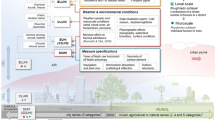Abstract
The urban heat island (UHI) of the city of Bucharest (Romania) is analyzed in terms of its extension, geometry, and magnitude using the surface thermal data provided by the moderate resolution imaging spectroradiometer (MODIS) sensors. An objective method is developed that allows to delineate the UHI. The study focuses on the months of July from the 2000–2006 time interval. The average surface temperatures obtained for each pixel (1 km resolution) were analyzed on cross-profiles that helped us to determine the outline of the UHI. The shifting points identified by the Rodionov test in the temperature series of each profile were considered as possible limits of the UHI. Seemingly, the land cover has a major influence on the extension and the geometry of the Bucharest UHI in July. The magnitude of the heat island was calculated by comparing the average temperature inside its limits and the average temperature of the 5 km (a) and of the 10 km (b) buffers around it. The thermal difference between the UHI and the surrounding area of Bucharest is higher and more variable during the daytime, and is noticeably related to the land cover.









Similar content being viewed by others
Notes
Most of these woodlands were cut off after July 2006, and future studies should probably reveal significant differences in the area than the present one.
References
Arnfield AJ (2003) Two decades of urban climate research: a review of turbulence, exchanges of energy and water, and the urban heat island. Int J Climatol 23:1–26
Dash P, Göttsche F-M Olesen F-S Fischer H (2002) Land surface temperature and emissivity estimation from passive sensor data: theory and practice–current trends. Int J Rem Sens 23(13):2563–2594
Hung T, Uchihama D, Ochi S, Yasuoka Y (2006) Assessment with satellite data of the urban heat island effects in Asian mega cities. Int J Appl Earth Obs Geoinform 8:34–48
Jin M, Shepherd JM (2005) Inclusion of urban landscape in a climate model. How can satellite data help? Bull Am Meteorol Soc 86(5):681–689
Jin M, Dickinson RE, Zhang D (2005) The footprint of urban areas on global climate as characterized by MODIS. J Climate 18:1551–1565
Jin M, Shepherd J M Peters-Lidard C (2007) Development of a parameterization for simulating the urban temperature hazard using satellite observations in climate model. Nat Hazards. DOI 10.1007/s11069–007–9117–2
Landsberg HE (1981) The urban climate. Academic, New York, 275 pp
Liu Y, Key JR (2003) Detection and analysis of clear-sky, low-level atmospheric yemperature inversions with MODIS. J Atm Ocean Technol 20:1727–1737
Mendelsohn R, Kurukulasuriya P, Basist A, Kogan F, Williams C (2007) Climate analysis with satellite versus weather station data. Climatic Change 81:71–83
Neacşa O, Popovici C (1969) Influence of the urban landscape on some parameters of the air temperature in the city of Bucharest (in Romanian). Institute of Meteorology, Bucharest, pp 293–304
Neacşa O, Popovici, C, Tuinea P, Popa G (1974) Contributions to the climatology of Bucharest (in Romanian). Institute of Meteorology and Hydrology, Bucharest, pp 5–53
Offerle B, Grimmond CSB, Fortuniak K, Pawlak W (2006) Intraurban differences of surface energy fluxes in a central European city. J Appl Meteor Climatol 45:125–136
Oke TR (1973) City size and the urban heat island. Atmos Environ 7:769–779
Oke TR (1984) Methods in urban climatology. In: Kirchofer W et al (ed) Applied climatology. Zürcher Geogr Schr 14:19–29
Oke TR (1987) Boundary Layer Climates, 2nd edn. Methuen, London, 435 pp
Pettit AN (1979) A non-parametric approach to the change point problem. Appl Stat 28:126–135
Pongracz R, Bartholy J, Dezso J (2005) Remotely sensed thermal information applied to urban climate analysis. Adv Space Res 37:2191–2196
Rodionov SN (2004) A sequential algorithm for testing climate regime shifts. Geophys Res Lett 31(9), L09204. DOI 10.1029/2004GL019448
Rodionov SN (2005) Detecting regime shifts in the mean and variance: Methods and specific examples. In: V Velikova and N Chipev (eds) Large-scale disturbances (regime shifts) and recovery in aquatic ecosystems: challenges for management toward sustainability. UNESCO-ROSTE/BAS Workshop on Regime Shifts, Varna, Bulgaria, 14–16 June 2005, pp 68–72
Spronken-Smith RA, Oke TR (1998) The thermal regime of urban parks in two cities with different summer climates. Int J Rem Sens 19:2085–2104
Streutker DR (2002) A remote sensing study of the urban heat island of Houston, Texas. Int J Rem Sens 23(13):2595–2608
Tumanov S, Stan-Sion A, Lupu A, Soci C, Oprea C (1999) Influences of the city of Bucharest on weather and climate parameters. Atmos Environ 33:4173–4183
Unger J, Sümeghy Z, Zoboki J (2001a) Temperature cross-section features in an urban area. Atmos Res 58:117–127
Unger J, Sümeghy Z, Gulyás Á, Bottyán Z, Mucsi L (2001b) Land-use and meteorological aspects of the urban heat island. Meteorol Appl 8:189–194
Voogt JA, Oke TR (2003) Thermal remote sensing of urban climates. Rem Sens Environ 86:370–384
Wan Z, Zhang Y, Zhang Q, Li Z-L (2004) Quality assessment and validation of the MODIS global land surface temperature. Int J Rem Sens 25(1):261–274
Acknowledgements
This research was carried out with the support of the Grant CEEX 701/2006 “Pledging the comfort and the energetic efficiency in buildings by using renewable sources (CEER)”, financed by the Ministry of Education and Research, Romania. We kindly thank Dr. I. Dima (University of Washington, USA), S. Mihai (DMTI Spatial, Canada), Dr. F. Olesen (Forschungszentrum Karlsruhe, Germany), and an anonymous reviewer for their useful comments and suggestions. We also express our gratitude to S. Ioan (National Meteorological Administration, Bucharest, Romania) for his meticulous help with the English. Special thanks to NASA for their generous effort of making satellite information about our planet available.
Author information
Authors and Affiliations
Corresponding author
Rights and permissions
About this article
Cite this article
Cheval, S., Dumitrescu, A. The July urban heat island of Bucharest as derived from modis images. Theor Appl Climatol 96, 145–153 (2009). https://doi.org/10.1007/s00704-008-0019-3
Received:
Accepted:
Published:
Issue Date:
DOI: https://doi.org/10.1007/s00704-008-0019-3




